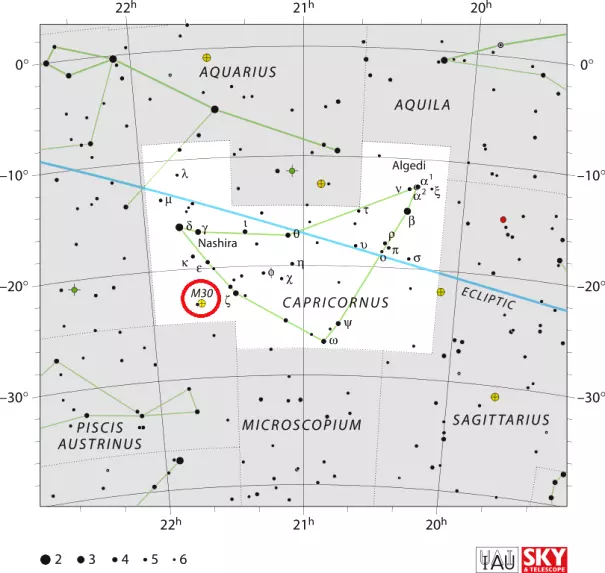A Messier marathon is an attempt to see all 110 Messier objects in a single night. Messier objects are bright deep sky objects catalogued by the French astronomer and comet hunter Charles Messier in the 18th century. These objects can be seen in binoculars and amateur telescopes. All are visible from the northern hemisphere for at least part of the year. In late March and early April, they can all be seen in one night from low to mid-northern latitudes.
Charles Messier compiled the Messier catalogue to help observers distinguish between comets and bright deep sky objects. However, the catalogue has long outgrown its original purpose to become the most widely used guide for visual astronomy in the northern hemisphere.
The Messier marathon was invented in the 1970s by three American amateur astronomers – Donald Machholz, Tom Hoffelder, and Tom Reiland – who independently challenged themselves to catch all the Messier objects in one night. The Observing Guide to the Messier Marathon: A Handbook and Atlas (2002) by Don Machholz is one of the most popular books among those planning their first marathon.
Messier marathons are usually organized by astronomy clubs in the early spring. The best dates to attempt a marathon are during the new Moon. Incomplete marathons can also be undertaken by amateur astronomers at other times of year. For an extra challenge, some astronomers attempt to photograph all the objects in a single night, but Messier marathons are generally an exercise in visual astronomy, not astrophotography.
Charles Messier made his observations from Paris, France, and his catalogue does not include objects in the far southern sky, invisible from mid-northern latitudes. The best latitude to attempt a Messier marathon is around 25° N. Low northern latitudes lend the opportunity to see all the 110 objects in a single night between mid-March and early April. Most objects can also briefly be seen around the September equinox, but incomplete Messier marathons can be attempted at any time of year.
Observers in the southern hemisphere can never see all the Messier objects in a single night. Objects like Bode’s Galaxy and the Cigar Galaxy (Messier 81 and 82) in Ursa Major and the open cluster Messier 52 in Cassiopeia are particularly hard because they lie north of declination 60° N. However, southern observers can use the Caldwell catalogue instead to attempt half-marathons, as it includes objects in both the northern and southern celestial hemispheres.
Telescopes for the Messier marathon
All Messier objects can be seen in small telescopes at low magnification. Modern-day 4-inch refractors and 6-inch reflectors have more light gathering power than some of the larger telescopes Charles Messier used, making it easy to hunt down all the objects in his catalogue from locations without too much light pollution.
Clear skies are key to seeing all the objects in one night. Difficult targets like the Owl Nebula (M97) and the Pinwheel Galaxy (M101) near the Big Dipper require dark, moonless skies to be seen. In good conditions, they can be glimpsed in binoculars. If there is too much light pollution, they will stay hidden even in 6-inch telescopes.
Messier himself used a Gregorian reflector with 7.5-inch aperture and later settled on 3.5-inch achromatic refractors when they became available. While he had the advantage of a dark, unpolluted 18th century night sky, his reflectors had mirrors of speculum metal, so even those with 7.5 to 8-inch aperture could not outperform some of the smaller instruments available today. For a list of telescopes Messier used, visit this SEDS page.
Messier marathon order
In order to see all 110 Messier objects in a single night, amateur astronomers attempting a Messier marathon use a special observing list that groups the objects by location. This way, they can catch the first objects on the list – the galaxies M77 and M74 – in the western sky after sunset and the last ones – the globular clusters M72 and M30 and the asterism M73 – in the southeast just before dawn. The list below works best for locations in mid-northern latitudes.
Messier marathon observing list
- Messier 77: Squid Galaxy
Constellation: Cetus
Apparent magnitude: 9.6
Apparent size: 7’.1 x 6’.0
The barred spiral galaxy M77 appears 0.74° southeast of Delta Ceti, a magnitude 4.06 star just south of the circle of stars that outline the head of Cetus. The galaxy can be seen in a small telescope. The fainter edge-on galaxy NGC 1055 lies in the vicinity. The head of Cetus can be found using the V of the Hyades as a pointer.
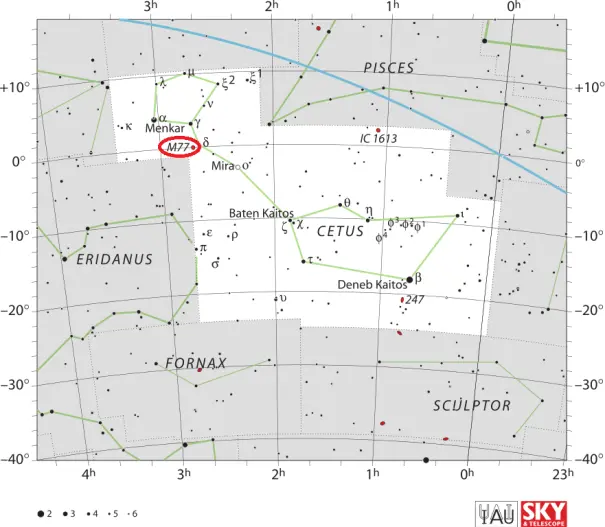
- Messier 74: Phantom Galaxy
Constellation: Pisces
Apparent magnitude: 10.0
Apparent size: 10’.5 x 9’.5
The spiral galaxy M74 is found 1.5° east-northeast of Alpherg (Eta Piscium), the brightest star in Pisces. Shining at magnitude 3.61, Alpherg is the brightest star southwest of the flat triangle formed by the brightest stars in Aries (Hamal, Sheratan and Mesarthim). The small, bright nucleus and faint halo of M74 are visible in small telescopes. The galaxy is a challenging object in less-than-ideal conditions because it has a low surface brightness.
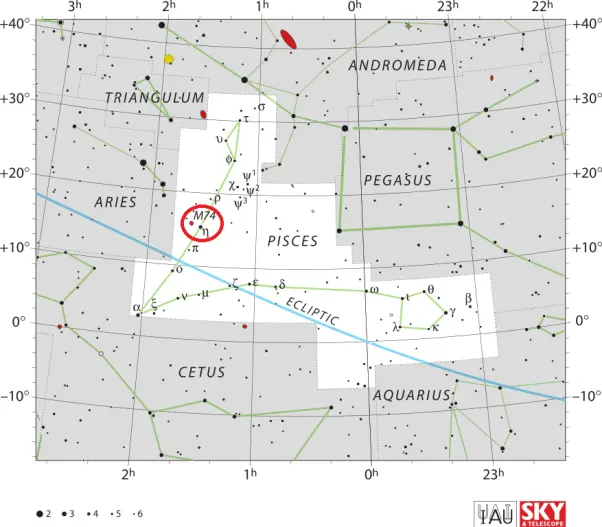
- Messier 33: Triangulum Galaxy
Constellation: Triangulum
Apparent magnitude: 5.72
Apparent size: 70’.8 x 41’.7
The Triangulum Galaxy (M33) appears 7° southwest of Mirach (Beta Andromedae), the central star in the chain of three stars that makes the constellation Andromeda recognizable. The galaxy appears 3.5° west-northwest of Mothallah (Alpha Trianguli), the star at the apex of the triangle asterism that gives the constellation Triangulum its name.
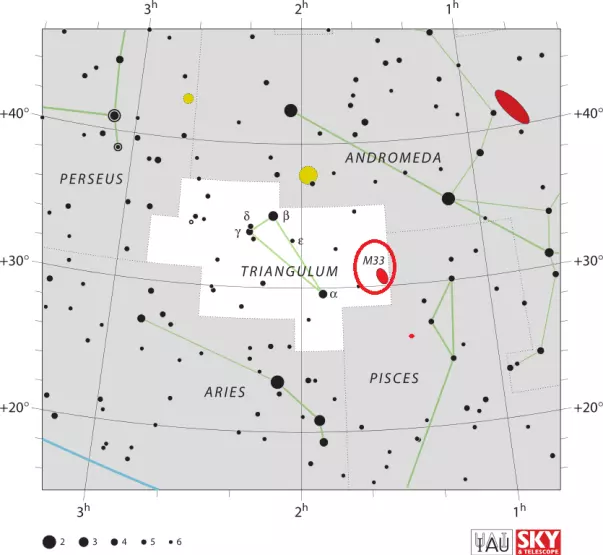
- Messier 31: Andromeda Galaxy
Constellation: Andromeda
Apparent magnitude: 3.44
Apparent size: 3.167° x 1°
The Andromeda Galaxy (M31) and its satellites M32 and M110 can be found using Mirach (Beta Andromedae), the central star in the chain of three stars that begins with Alpheratz in the Square of Pegasus and ends with Almach (Gamma Andromedae) near the border with the constellation Perseus. The M31 galaxy lies about 8° northwest of Mirach. In good conditions, it is visible to the unaided eye and can also be observed in small binoculars.
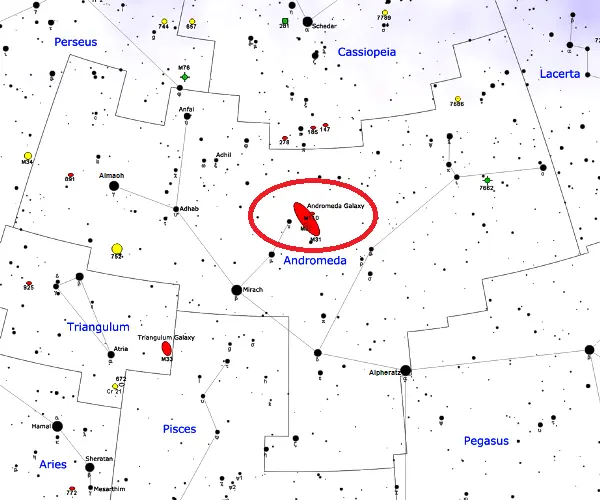
- Messier 32
Constellation: Andromeda
Apparent magnitude: 8.08
Apparent size: 8’.7 × 6’.5
The dwarf elliptical galaxy M32 is the smaller and slightly brighter of the two Andromeda satellites catalogued by Messier. It lies closer to the larger M31.
- Messier 110
Constellation: Andromeda
Apparent magnitude: 8.92
Apparent size: 21’.9 x 11’.0
The dwarf elliptical galaxy M110 is the larger and fainter Andromeda satellite. It appears a little further away from Andromeda than M32.
- Messier 52
Constellation: Cassiopeia
Apparent magnitude: 6.9
Apparent size: 13’
The open cluster M52 can be located using the bright stars of Cassiopeia’s W. An imaginary line drawn from Schedar (Alpha Cassiopeiae) through Caph (Beta Cassiopeiae) and extended by the same distance as that between the two stars leads to the cluster. The Bubble Nebula (NGC 7635) appears only 35’ southwest of M52.
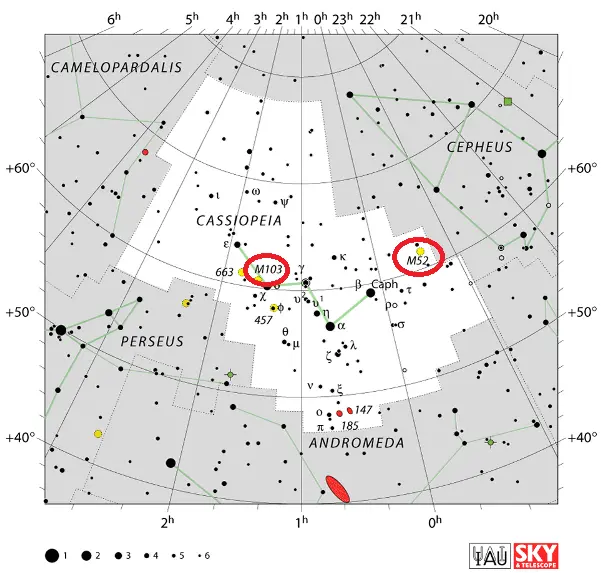
- Messier 103
Constellation: Cassiopeia
Apparent magnitude: 7.4
Apparent size: 6’.0
The open cluster M103 appears only 1° east of Ruchbah (Delta Cassiopeiae), the bottom left star of Cassiopeia’s W. The cluster lies close to the imaginary line connecting Ruchbah and Segin (Epsilon Cassiopeiae), the top left star of the W asterism.
- Messier 76: Little Dumbbell Nebula
Constellation: Perseus
Apparent magnitude: 10.1
Apparent size: 2’.7 x 1’.8
The Little Dumbbell Nebula (M76) is located about 1° north-northwest of Alseiph (Phi Persei). The star and the nebula lie close to the border with the constellation Andromeda. Alseif is the brightest star along the imaginary line extended from Almach (Gamma Andromedae) in Andromeda to Gamma Cassiopeiae, the central star of Cassiopeia’s W. It shines at magnitude 4.06.
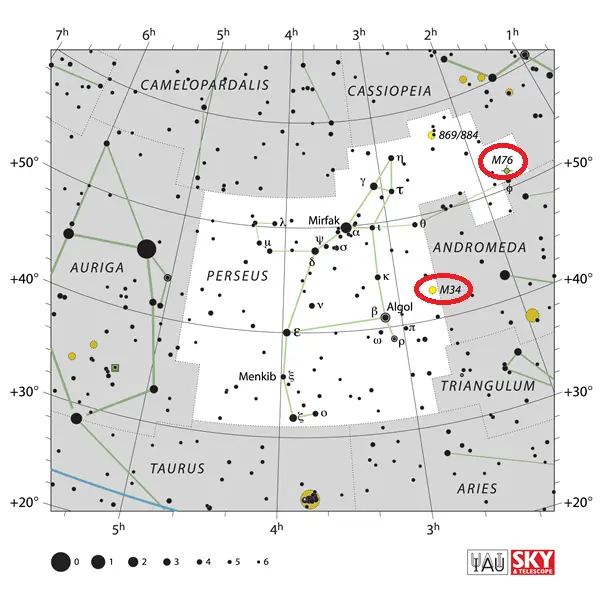
- Messier 34
Constellation: Perseus
Apparent magnitude: 5.5
Apparent size: 35’
The open cluster M34 is found just north of the imaginary line connecting Algol (Beta Persei) in the constellation Perseus and Almach (Gamma Andromedae) in Andromeda. The cluster appears 5° northwest of Algol.
- Messier 45: The Pleiades
Constellation: Taurus
Apparent magnitude: 1.6
Apparent size: 110’
The Pleiades cluster (M45) is exceptionally bright and large, appearing like a bunch of grapes in the night sky. It can be located by extending the line formed by the three stars of Orion’s Belt by about 14° past Aldebaran (Alpha Tauri), the brightest star in Taurus. The Hyades cluster appears in the same line of sight as Aldebaran and is another easy telescope target in Taurus.
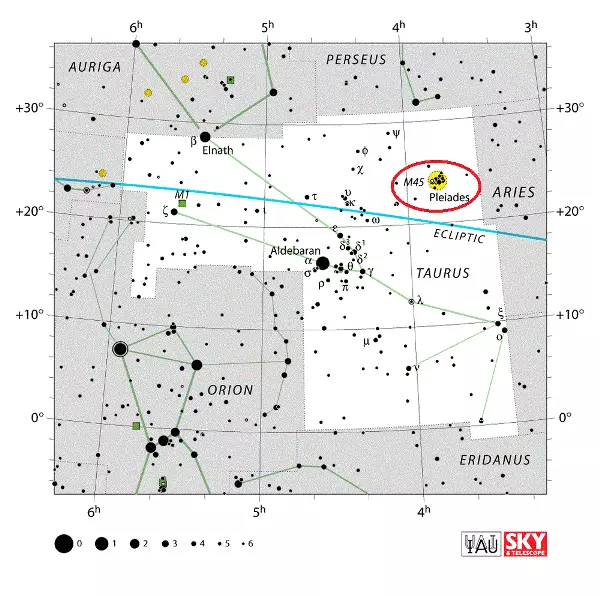
- Messier 79
Constellation: Lepus
Apparent magnitude: 8.56
Apparent size: 8’.7
The globular cluster M79 appears about 20° southwest of Sirius (Alpha Canis Majoris). It can be found by extending a line from Arneb (Alpha Leporis) through Nihal (Beta Leporis) by 1.5 times the distance between the two stars. Arneb and Nihal are part of a quadrilateral asterism in the constellation figure of the Hare. The asterism is found under Orion’s feet, marked by Rigel (Beta Orionis) and Saiph (Kappa Orionis).
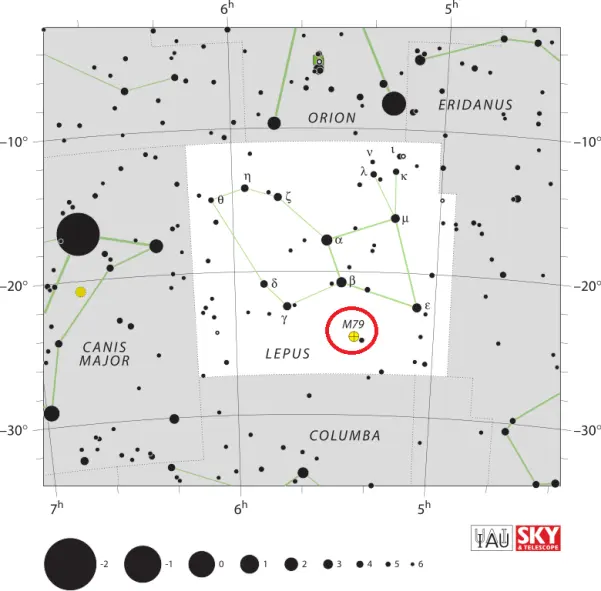
- Messier 42: Orion Nebula
Constellation: Orion
Apparent magnitude: 4.0
Apparent size: 65’ x 60’
The Orion Nebula (M42) appears as the central star in Orion’s Sword, a prominent asterism located just below Orion’s Belt. The nebula is visible to the unaided eye. The stars of the central Trapezium Cluster can be resolved in small telescopes at higher magnifications.
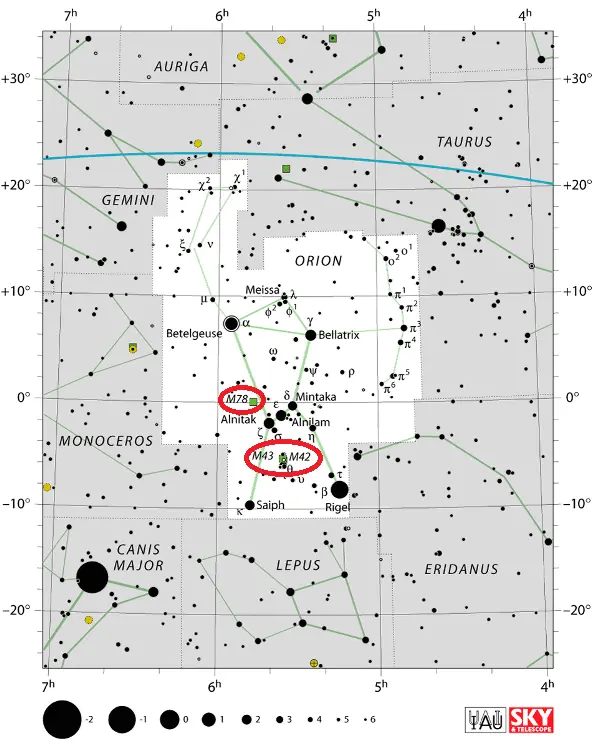
- Messier 43: De Mairan’s Nebula
Constellation: Orion
Apparent magnitude: 9.0
Apparent size: 20’ x 15’
De Mairan’s Nebula (M43) is part of the larger Orion Nebula (M42). It is separated from M42 by a dark dust lane and appears north of the main nebula. M43 is visible in binoculars and small telescopes, but the dark, wispy features on the nebula’s eastern border can only be seen in 8-inch and larger telescopes.
- Messier 78
Constellation: Orion
Apparent magnitude: 8.3
Apparent size: 8’ x 6’
The reflection nebula M78 is easily found because it lies within the bright constellation figure of Orion. It appears about 2° north and 1.5° east of Alnitak, the left star of Orion’s Belt. The nebula can be found near the intersection of the imaginary lines drawn from Betelgeuse to Alnitak and from Bellatrix to Sirius. It requires good condition to be seen.
- Messier 41
Constellation: Canis Major
Apparent magnitude: 4.5
Apparent size: 38’
The open cluster M41 appears about 4° south of Sirius, the brightest star in the sky. The cluster is visible in binoculars and easily observed in small telescopes.
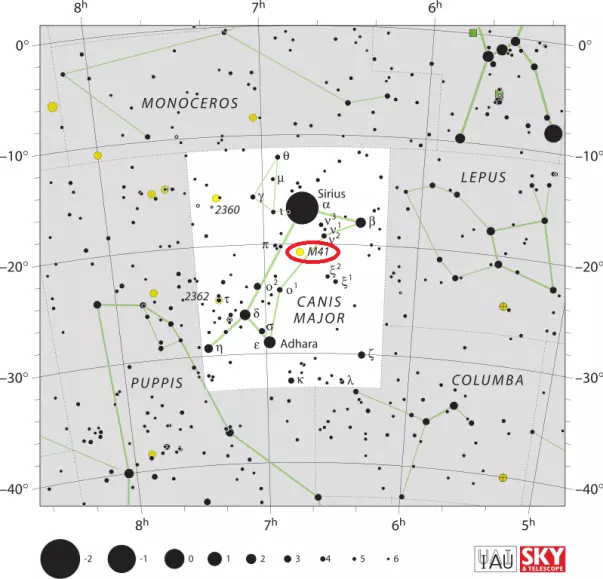
- Messier 93
Constellation: Puppis
Apparent magnitude: 6.2
Apparent size: 10’
The open cluster M93 appears in the same area of the sky as Sirius, just northwest of the multiple star system Xi Puppis. Xi Puppis is found at the intersection of the imaginary lines extended from Castor through Procyon and from Saiph through Sirius.
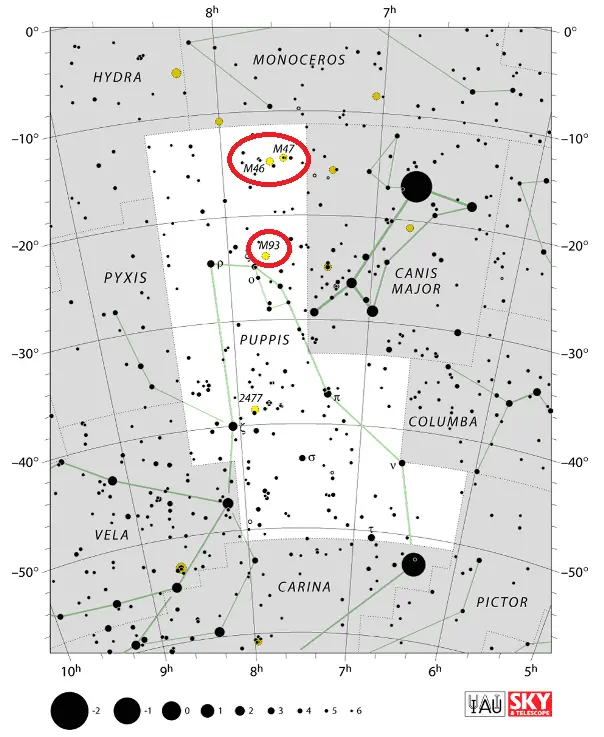
- Messier 47
Constellation: Puppis
Apparent magnitude: 4.2
Apparent size: 30’
The open cluster M47 appears in the northern part of Puppis, 12° east and 2° north of Sirius. Its brightest stars are visible in small binoculars.
- Messier 46
Constellation: Puppis
Apparent magnitude: 6.1
Apparent size: 22’.8
The open cluster M46 appears about 1° east of M47. The two clusters lie in the same binocular field of view. M46 is fainter and more distant than its neighbour.
- Messier 50
Constellation: Monoceros
Apparent magnitude: 5.9
Apparent size: 16’
The open cluster M50 appears about two fifths of the way from Sirius to Procyon. It lies 8° north and 3° east of Sirius. It can be observed in small telescopes.
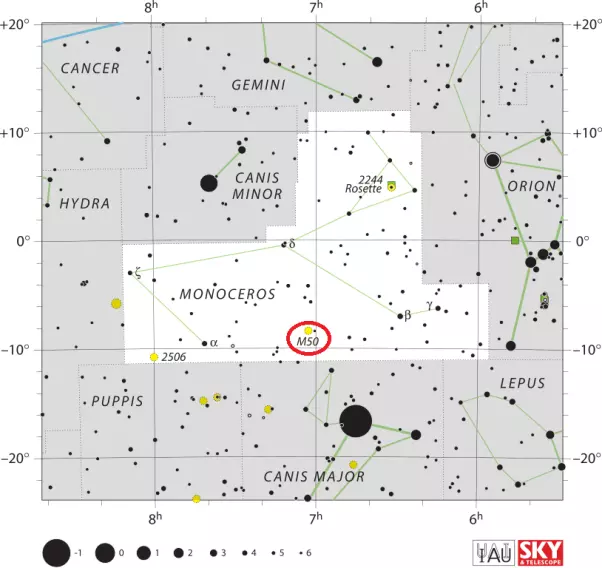
- Messier 48
Constellation: Hydra
Apparent magnitude: 5.8
Apparent size: 30’
The open cluster M48 appears about 14° southeast of Procyon and 18° 34’ east-southeast of Alphard, the brightest star in Hydra. It lies south of the asterism outlining the head of Hydra. The cluster is best seen in small telescopes at low magnification.
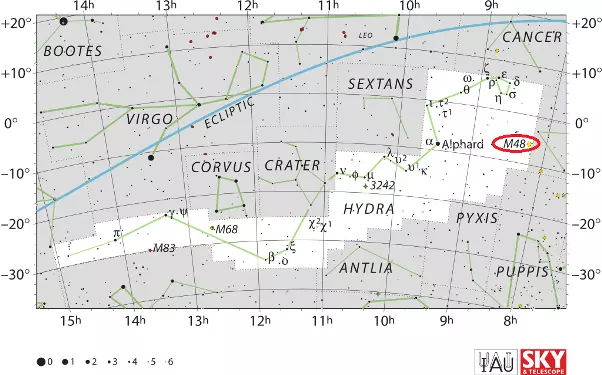
- Messier 1: Crab Nebula
Constellation: Taurus
Apparent magnitude: 8.4
Apparent size: 420’’ x 290’’
The Crab Nebula (M1) appears 1° northwest of Tianguan (Zeta Tauri), the blue giant star that marks the southern horn of the Bull. The supernova remnant lies on the imaginary line connecting Zeta Tauri and Elnath (Beta Tauri), the star that marks the Bull’s northern horn. M1 is visible in small telescopes, but its structure and filaments can only be glimpsed in larger instruments.
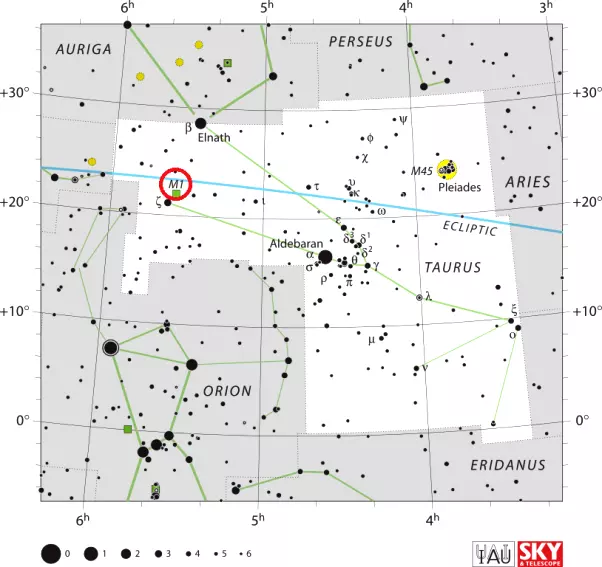
- Messier 35
Constellation: Gemini
Apparent magnitude: 5.1
Apparent size: 28’
The open cluster M35 is found about 2° northwest of Propus (Eta Geminorum), the star that marks the foot of Castor in Gemini. The brightest stars in the cluster can be resolved in binoculars, while 6-inch telescopes reveal a full star field across the cluster.
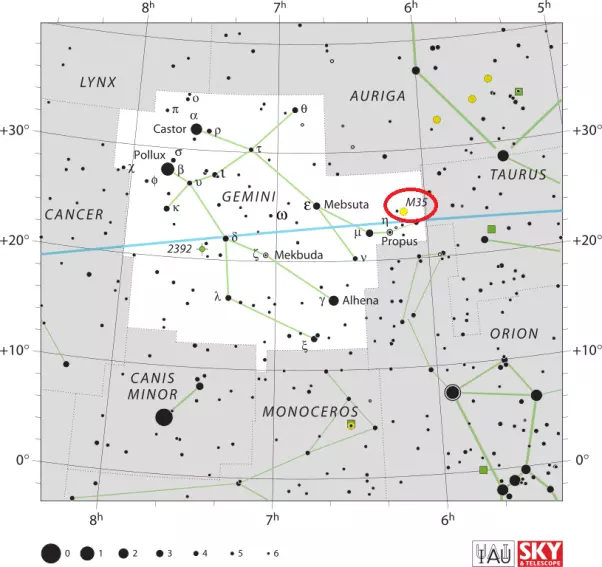
- Messier 37
Constellation: Auriga
Apparent magnitude: 6.2
Apparent size: 24’
The open cluster M37 appears just outside Auriga’s hexagon pattern, east of the midpoint of the imaginary line extended from Mahasim (Theta Aurigae) to Elnath (Beta Tauri). The cluster can be observed in larger binoculars and small telescopes.
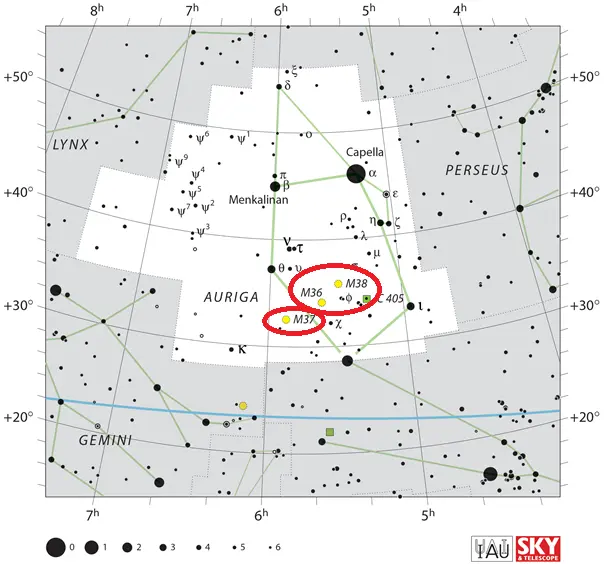
- Messier 36: Pinwheel Cluster
Constellation: Auriga
Apparent magnitude: 6.3
Apparent size: 10’
The open cluster M36 appears within Auriga’s hexagon, along the imaginary line drawn from Elnath (Beta Tauri) to Menkalinan (Beta Aurigae). It lies just west of the midpoint of the line connecting Mahasim (Theta Aurigae) and Elnath (Beta Tauri), opposite M37.
- Messier 38: Starfish Cluster
Constellation: Auriga
Apparent magnitude: 7.4
Apparent size: 21’
The open cluster M38 appears about two thirds of the way from Capella (Alpha Aurigae) to Elnath (Beta Tauri), roughly halfway between Mahasim (Theta Aurigae) and Hassaleh (Iota Aurigae). The cluster lies 2.3° northwest of M36.
- Messier 44: Beehive Cluster (Praesepe)
Constellation: Cancer
Apparent magnitude: 3.7
Apparent size: 95’
The open cluster M44 lies almost halfway between Pollux in Gemini and Regulus in Leo. The cluster is easier to see than its host constellation. In good conditions, it is visible to the unaided eye between the Sickle of Leo and Alhena in Gemini. Praesepe is easily observed in binoculars and small telescopes at low power.
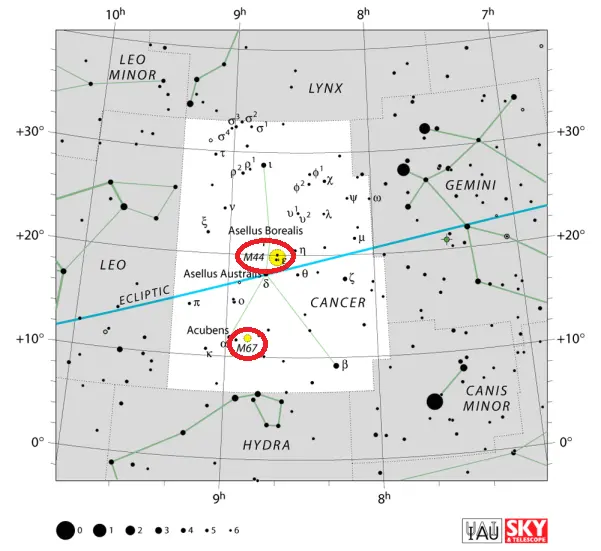
- Messier 67
Constellation: Cancer
Apparent magnitude: 6.1
Apparent size: 30’
The open cluster M67 appears about halfway and just above the imaginary line connecting Regulus in Leo and Procyon in Canis Minor. It lies between Praesepe (M44) and the rectangular asterism outlining the head of Hydra. The brightest stars in the cluster can be resolved in a small telescope.
- Messier 95: Leo I Group
Constellation: Leo
Apparent magnitude: 11.4
Apparent size: 3’.1 x 2’.9
The barred spiral galaxy M95 is a member of the Leo I Group, along with M96 and M105. The group appears roughly a third of the way from Regulus (Alpha Leonis) to Denebola (Beta Leonis). M105 is the northernmost galaxy in the group, located on the imaginary line from Regulus to Denebola. M96, the brightest member of the group, appears 50’ south of M105, and M95 lies 40’ east of M95.
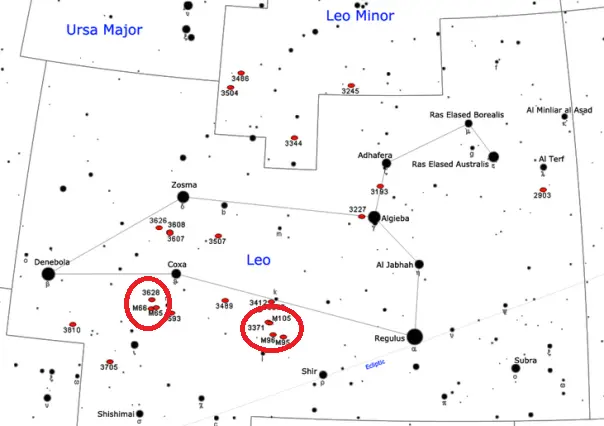
- Messier 96: Leo I Group
Constellation: Leo
Apparent magnitude: 10.1
Apparent size: 7’.6 x 5’.2
- Messier 105: Leo I Group
Constellation: Leo
Apparent magnitude: 10.2
Apparent size: 5’.4 x 4’.8
- Messier 65: Leo Triplet
Constellation: Leo
Apparent magnitude: 10.25
Apparent size: 8’.709 x 2’.454
The spiral galaxies M65, M66 and NGC 3628 (Sarah’s Galaxy) form the Leo Triplet. M65 appears along the line extended from Denebola to Regulus, halfway between the stars Iota and Theta Leonis. M66 is found 0.33° southeast of M65, while the third member, NGC 3628, lies 0.5° north of the pair. M65 and M66 are visible in small telescopes, while NGC 3628 requires a 6-inch or larger instrument.
- Messier 66: Leo Triplet
Constellation: Leo
Apparent magnitude: 8.9
Apparent size: 9’.1 x 4’.2
- Messier 81: Bode’s Galaxy
Constellation: Ursa Major
Apparent magnitude: 6.94
Apparent size: 26’.9 x 14’.1
The galaxies M81 and M82 make a striking pair, appearing in a single field of view about 10° northwest of Dubhe (Alpha Ursae Majoris). They can be found by extending a line from Phecda (Gamma Ursae Majoris) through Dubhe by about the same distance as that between the two stars. The galaxies are visible in binoculars and small telescopes. 6-inch and larger instruments reveal the cores and some of the details on the surfaces of the pair.
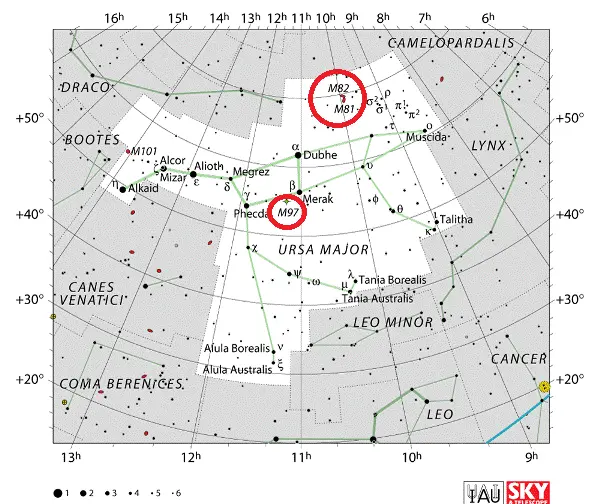
- Messier 82: Cigar Galaxy
Constellation: Ursa Major
Apparent magnitude: 8.41
Apparent size: 11’.2 x 4’.3
- Messier 97: Owl Nebula
Constellation: Ursa Major
Apparent magnitude: 9.9
Apparent size: 3’.4 x 3’.3
The Owl Nebula (M97) appears 2.5° southeast of Merak (Beta Ursae Majoris), in the direction of Phecda (Gamma Ursae Majoris). The nebula is one of the more challenging Messier objects to see. It is visible in binoculars and small telescopes, but it requires exceptionally clear, dark skies and only appears as a dim patch of light. The owl-like eyes only appear in 10-inch and larger instruments.
- Messier 108
Constellation: Ursa Major
Apparent magnitude: 10.7
Apparent size: 8’.7 x 2’.2
The barred spiral galaxy M108 appears only 1.5° southeast of Merak (Beta Ursae Majoris), in the same wide field of view as the Owl Nebula (M97). Small telescopes reveal only a long streak of light with a brighter core and 8-inch instruments will show some of the galaxy’s dusty regions.
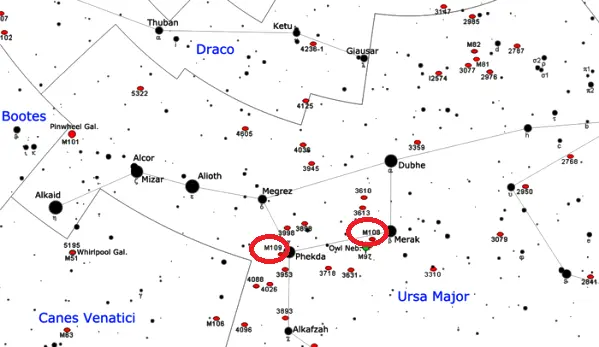
- Messier 109
Constellation: Ursa Major
Apparent magnitude: 10.6
Apparent size: 7’.6 x 4’.7
The barred spiral galaxy M109 lies only 40 arcminutes southeast of Phecda (Gamma Ursae Majoris) in the Big Dipper. It is visible in small telescopes but requires exceptionally good conditions.
- Messier 40: Winnecke 4
Constellation: Ursa Major
Apparent magnitude: 9.64, 10.11
The visual double star Winnecke 4 lies about 1.5° northeast of Megrez (Delta Ursae Majoris) in the Big Dipper. It can be found by first star-hopping to the magnitude 5.54 star 70 Ursae Majoris. M40 appears only 17 arcminutes northeast of the star.
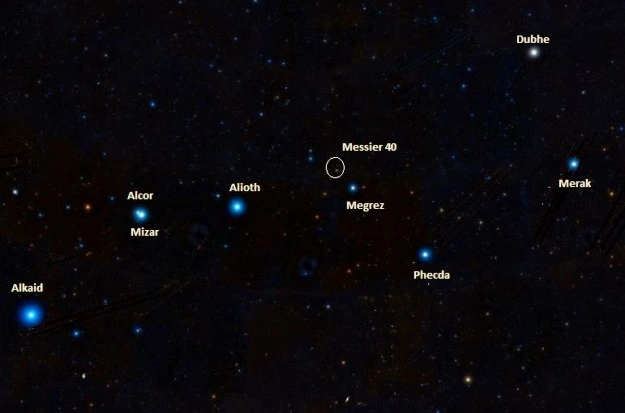
- Messier 106
Constellation: Canes Venatici
Apparent magnitude: 8.4
Apparent size: 18’.6 x 7’.2
The spiral galaxy M106 can be found by extending a line from Dubhe (Alpha Ursae Majoris) through Phecda (Gamma Ursae Majoris) in the direction of Cor Caroli (Alpha2 Canum Venaticorum). The galaxy has a high surface brightness and is visible in binoculars. Some details of its structure can be seen in 8-inch and larger telescopes.
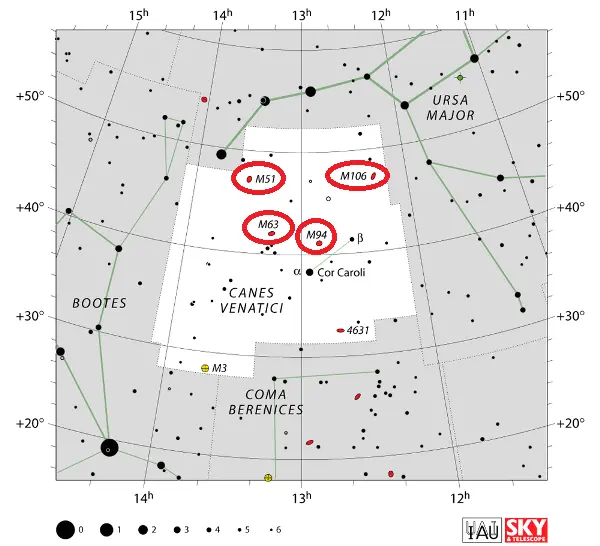
- Messier 94: Cat’s Eye Galaxy
Constellation: Canes Venatici
Apparent magnitude: 8.99
Apparent size: 11’.2 x 9’.1
The spiral galaxy M94 appears 3° east-southeast of Chara (Beta Canum Venaticorum), the second brightest star in Canes Venatici constellation. Chara is found just over 5° northwest of Cor Caroli. The galaxy requires good observing conditions. It can be seen in small telescopes, but only appears as a small, faint patch of light. The bright nucleus and hints of the galaxy’s spiral structure can be glimpsed in 6-inch and 8-inch telescopes.
- Messier 63: Sunflower Galaxy
Constellation: Canes Venatici
Apparent magnitude: 9.3
Apparent size: 12’.6 x 7’.2
The spiral galaxy M63 appears about two thirds of the way from Alkaid (Eta Ursae Majoris), the star at the tip of the Great Bear’s tail, to Cor Caroli, the brightest star in Canes Venatici. The galaxy is visible in binoculars, but its spiral arms can only be seen in 8-inch and larger telescopes.
- Messier 51: Whirlpool Galaxy
Constellation: Canes Venatici
Apparent magnitude: 8.4
Apparent size: 11’.2 x 6’.9
The Whirlpool Galaxy (M51) lies 3.5° southwest of Alkaid (Eta Ursae Majoris), in the direction of Cor Caroli (Alpha2 Canum Venaticorum). It appears as a patch of light in binoculars in good conditions. The galaxy’s smaller companion, NGC 5195, can be seen in small telescopes, but the bridge connecting the pair is only visible in larger instruments.
- Messier 101: Pinwheel Galaxy
Constellation: Ursa Major
Apparent magnitude: 7.86
Apparent size: 28’.8 x 26’.9
The spiral galaxy M101 appears just above the Big Dipper’s handle. It forms a triangle with Alkaid (Eta Ursae Majoris) and Mizar (Zeta Ursae Majoris). The galaxy is quite large but has a very low surface brightness and requires exceptionally clear, dark skies. In good conditions, it can be seen in binoculars.
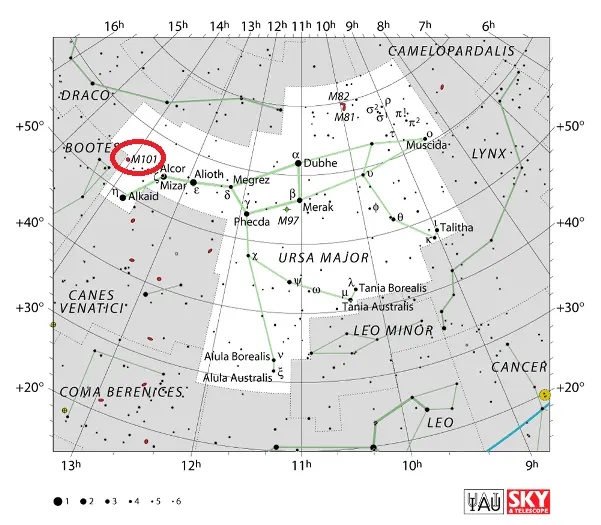
- Messier 102
Constellation: Draco
Apparent magnitude: 10.7
Apparent size: 4’.7 x 1’.9
The lenticular galaxy M102 appears 4° southwest of Edasich (Iota Draconis), roughly halfway between Athebyne (Eta Draconis) and Alkaid (Eta Ursae Majoris). The galaxy is visible in small telescopes, but only appears as an elongated patch of light in good conditions. Larger telescopes reveal the galaxy’s halo and hints of its dark dust lane.
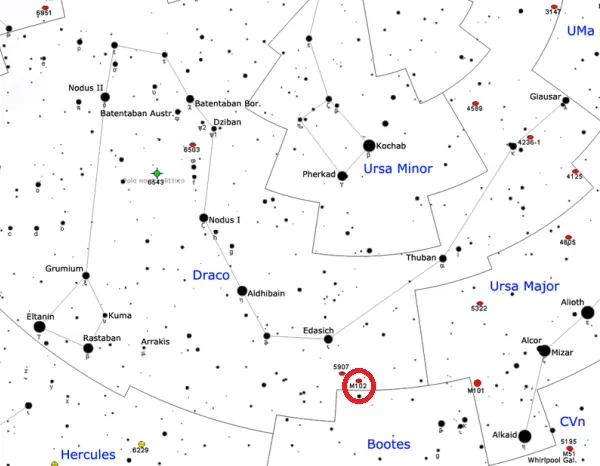
- Messier 53
Constellation: Coma Berenices
Apparent magnitude: 8.33
Apparent size: 13’
The globular cluster M53 appears 15° west of Arcturus, in the eastern part of the constellation Coma Berenices. It lies only 1° northeast of the magnitude 4.32 star Diadem (Alpha Comae Berenices). M53 appears along the imaginary line extended from Arcturus through Muphrid (Eta Boötis) about 11° to the west.
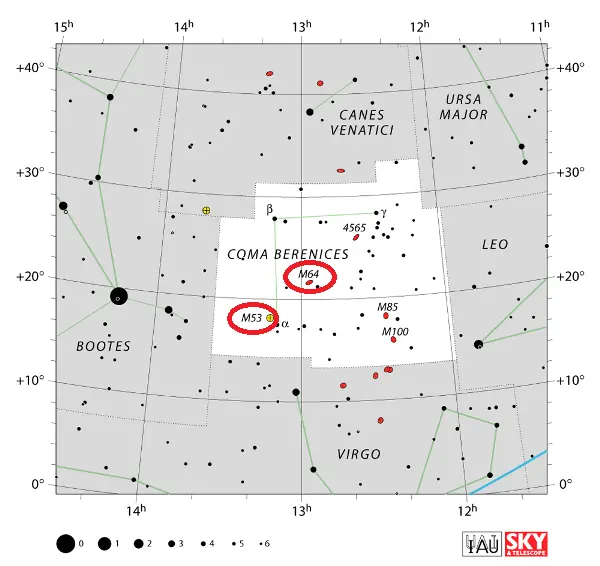
- Messier 64: Black Eye Galaxy
Constellation: Coma Berenices
Apparent magnitude: 8.52
Apparent size: 10’.71 x 5’.128
The spiral galaxy M64 lies about halfway and north of the imaginary line connecting Arcturus in Boötes and Denebola in Leo. It appears near the line extended from Cor Caroli in Canes Venatici to Vindemiatrix in Virgo, 1° northeast of 35 Comae Berenices and 19° west and a little north of Arcturus. The galaxy’s bright core can be seen in small telescopes. 6-inch and 8-inch instruments reveal the prominent dark dust lane in good conditions.
- Messier 3
Constellation: Canes Venatici
Apparent magnitude: 6.2
Apparent size: 18’
The globular star cluster M3 appears roughly halfway from Arcturus in Boötes to Cor Caroli in Canes Venatici. It is found about 6° north-northeast of Beta Comae Berenices. The cluster is easily observed in binoculars and small telescopes.
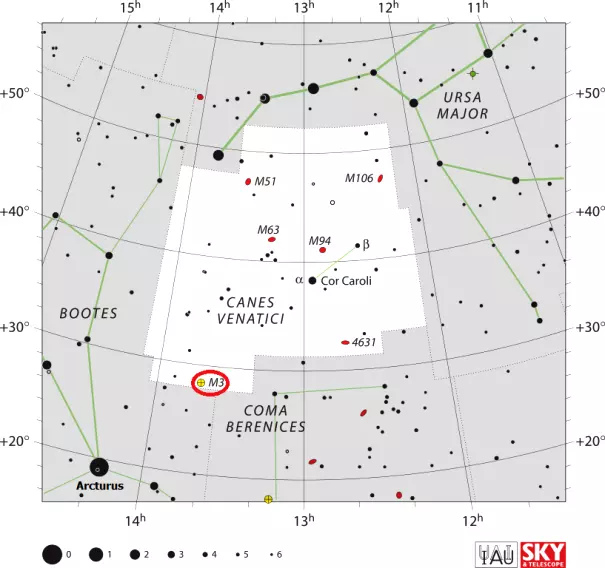
- Messier 98
Constellation: Coma Berenices
Apparent magnitude: 11.0
Apparent size: 9’.8 x 2’.8
The spiral galaxy M98 is a member of the Virgo Cluster of galaxies. It lies 6° east of Denebola in Leo and 0.5° of the much fainter 6 Comae Berenices. The galaxy is a challenging target. It requires at least a 4-inch telescope and ideal viewing conditions. It is significantly fainter than the nearby M99 and M100.
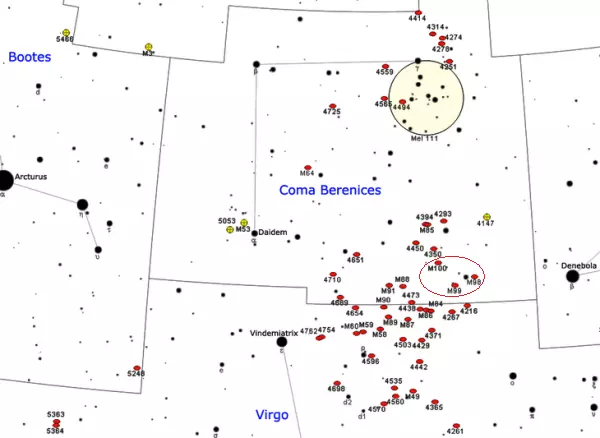
- Messier 99: Coma Pinwheel Galaxy
Constellation: Coma Berenices
Apparent magnitude: 10.4
Apparent size: 5’.4 x 4’.7
The grand design spiral galaxy M99 is a member of the Virgo Cluster. It appears 7° east of Denebola at the Lion’s tail and less than 1° southeast of the magnitude 5.1 star 6 Comae Berenices.
- Messier 100
Constellation: Coma Berenices
Apparent magnitude: 9.5
Apparent size: 7’.4 x 6’.3
Messier 100 is another grand design spiral galaxy in the Virgo Cluster. It lies along the imaginary line extended from Denebola in Leo toward Diadem in Coma Berenices and Arcturus in Boötes. The galaxy appears 2° southeast of the magnitude 4.7 star 11 Comae Berenices. It has a low surface brightness and requires clear, dark skies to be seen. In good conditions, M100 is visible in large binoculars and small telescopes.
- Messier 85
Constellation: Coma Berenices
Apparent magnitude: 10.0
Apparent size: 7’.1 x 5’.5
Messier 85 is the northernmost Messier galaxy that is a member of the Virgo Cluster. It appears roughly 6° northwest of the cluster’s centre, which lies halfway between Denebola in Leo and Vindemiatrix in Virgo. The galaxy lies 1° northeast of the magnitude 4.7 star 11 Comae Berenices and just north of M100. It appears as a fuzzy ball of light with a bright centre in small telescopes.
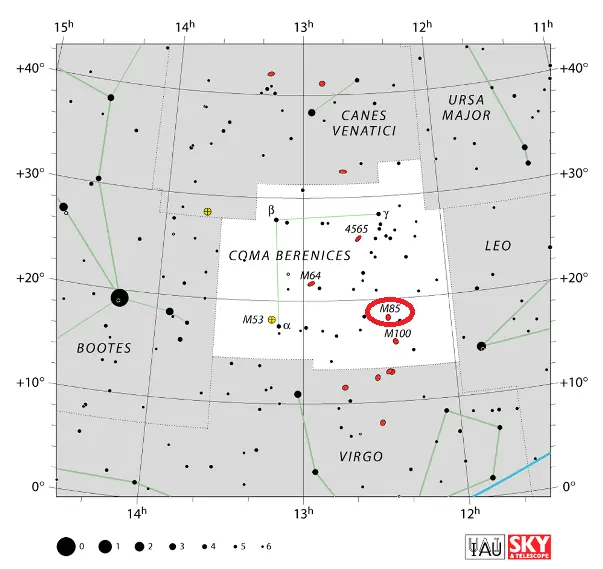
- Messier 84
Constellation: Virgo
Apparent magnitude: 10.1
Apparent size: 6’.5 x 5’.6
Messier 84 lies near the centre of the Virgo Cluster, roughly halfway between Vindemiatrix in Virgo and Denebola in Leo. It appears in the same wide field of view as M86, which lies only 17 arcminutes east of M84. Even though it is one of the brighter members of the Virgo Cluster, M84 requires clear, dark skies to be seen. It is visible in large binoculars and small telescopes.
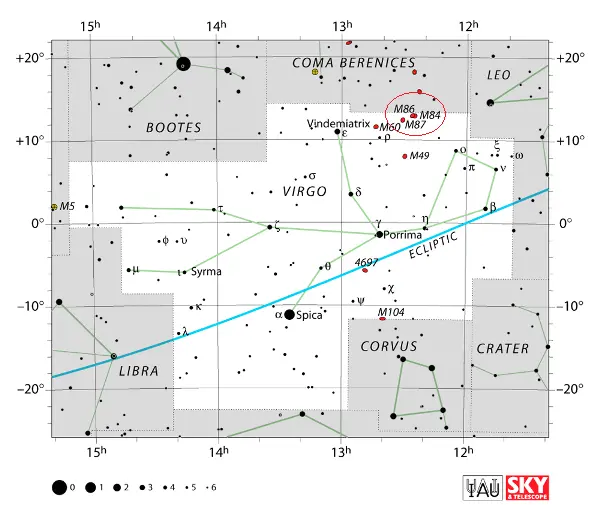
- Messier 86
Constellation: Virgo
Apparent magnitude: 9.83
Apparent size: 8’.9 x 5’.8
Messier 86 appears almost exactly halfway between Denebola and Vindemiatrix. It forms a pair with the nearby M84. The giant elliptical galaxy M87 appears only 1.5° southeast of the pair. M86 appears as a dim patch of light in binoculars in good conditions. The brighter core is visible in small and medium telescopes.
- Messier 87: Virgo A
Constellation: Virgo
Apparent magnitude: 8.79
Apparent size: 7’.2 x 6’.8
The supergiant elliptical galaxy M87 appears just a little more than halfway between Denebola and Vindemiatrix. It can be found using the M84/M86 pair, located almost exactly halfway between the two stars. M87 lies about 1.5° southeast of the pair. It is visible in binoculars and small telescopes.
- Messier 89
Constellation: Virgo
Apparent magnitude: 9.8
Apparent size: 5’.1 x 4’.7
The elliptical galaxy M89 appears 1° east of M87 and about 2° west of the star Rho Virginis. It lies near the centre of the Virgo Cluster, about 60% of the way from Denebola to Vindemiatrix. The brighter spiral galaxy M90 appears only 0.75° to the northeast and the barred spiral galaxy M58 lies 1° southeast. M89 is fainter than some other members of the Virgo Cluster and can be a challenging object in small telescopes. It appears as a faint ball of light in 8-inch telescopes.
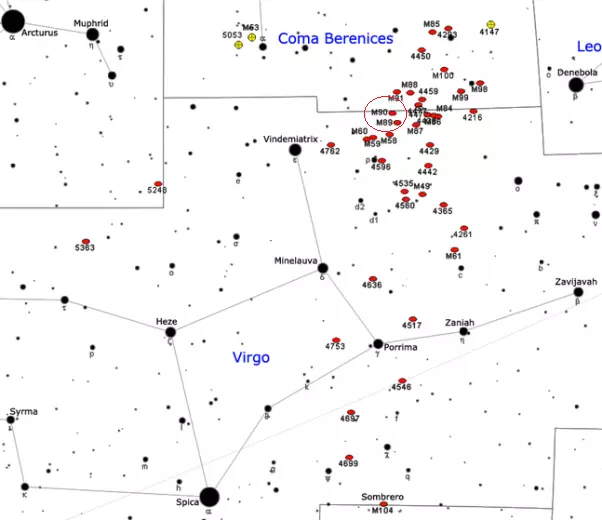
- Messier 90
Constellation: Virgo
Apparent magnitude: 10.26
Apparent size: 9’.5 x 4’.4
The spiral galaxy M90 lies 1.5° northeast of M87 and 0.75° northeast of M89. The galaxy is visible in binoculars in exceptionally good conditions. The spiral structure can only be seen in larger telescopes.
- Messier 88
Constellation: Coma Berenices
Apparent magnitude: 10.4
Apparent size: 6’.9 x 3’.7
The spiral galaxy M88 lies north-northeast of the M84/M86 pair, north of the line connecting Vindemiatrix and Denebola. In good conditions, the galaxy can be seen in binoculars. The details of its structure can be observed in larger telescopes.
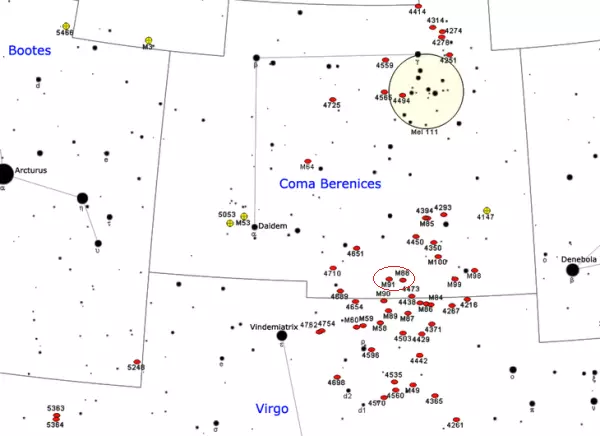
- Messier 91
Constellation: Coma Berenices
Apparent magnitude: 11.0
Apparent size: 5’.4 x 4’.3
The barred spiral galaxy M91 appears 2° north of the brighter M89, near M90. It is the faintest Messier object and one of the most challenging to observe. It requires clear, dark skies. The galaxy can be glimpsed in small telescopes, which reveal hints of the bar structure. In 6-inch and 8-inch telescopes, it appears as a dim patch of light with a brighter core. The spiral arms can be observed in larger instruments in good conditions.
- Messier 58
Constellation: Virgo
Apparent magnitude: 10.5
Apparent size: 5’.9 x 4’.7
The barred spiral galaxy M58 appears south of the line connecting Vindemiatrix and Denebola, about 2° northwest of Rho Virginis. It lies about 1° west of M59.
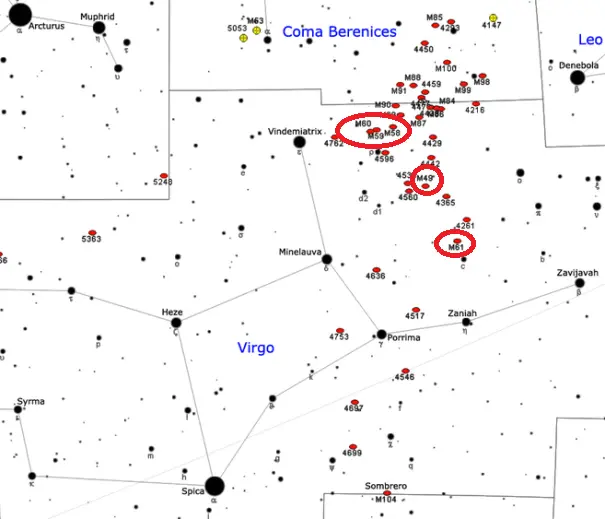
- Messier 59
Constellation: Virgo
Apparent magnitude: 10.6
Apparent size: 5’.4 x 3’.7
The elliptical galaxy M59 lies just west of the giant elliptical M60, which appears 4.5° west of Vindemiatrix. M59 is best observed in larger telescopes.
- Messier 60
Constellation: Virgo
Apparent magnitude: 9.8
Apparent size: 7’.4 x 6’.0
The giant elliptical galaxy M60 is the third brightest and easternmost Messier galaxy in the Virgo Cluster. It lies 4.5° from Vindemiatrix in the direction of Denebola. The fainter M59 appears only 25 arcminutes away. The two galaxies can be seen in the same wide field of view. Small telescopes will also reveal the intermediate spiral galaxy NGC 4647, which forms a pair known as Arp 116 with M60.
- Messier 49
Constellation: Virgo
Apparent magnitude: 9.4
Apparent size: 10’.2 x 8’.3
The elliptical galaxy M49 lies 4.1° west-southwest of Vindemiatrix and about 5° south of the centre of the Virgo Cluster. It can be glimpsed in larger binoculars in good conditions, and its bright core is visible in 4-inch telescopes. Larger instruments reveal the bright centre and large halo.
- Messier 61
Constellation: Virgo
Apparent magnitude: 10.18
Apparent size: 6’.5 x 5’.8
The barred spiral galaxy M61 lies in the southern portion of the Virgo Cluster. It can be found using the stars of the Y of Virgo. The galaxy appears 8° northwest of Porrima (Gamma Virginis) in the direction of Denebola, just above the imaginary line connecting Minelauva (Delta Virginis) and Zavijava (Beta Virginis). M61 is visible in small telescopes. The galaxy’s spiral structure is best observed in 10-inch and larger instruments.
- Messier 104: Sombrero Galaxy
Constellation: Virgo
Apparent magnitude: 8.0
Apparent size: 9’ x 4’
The Sombrero Galaxy (M104) lies near the border with the constellation Corvus and can be found using the stars of Spica’s Spanker (the Sail), an asterism formed by the brightest stars of Corvus. The galaxy appears 11.5° west of Spica and 5.55° east of Eta Corvi, a faint star in the same field of view as Algorab (Delta Corvi). The Sombrero Galaxy is visible in binoculars in good conditions, but only appears as a small patch of light. The galaxy’s dark dust lane normally requires at least a 10-inch telescope but may be glimpsed in smaller instruments in exceptionally good conditions.
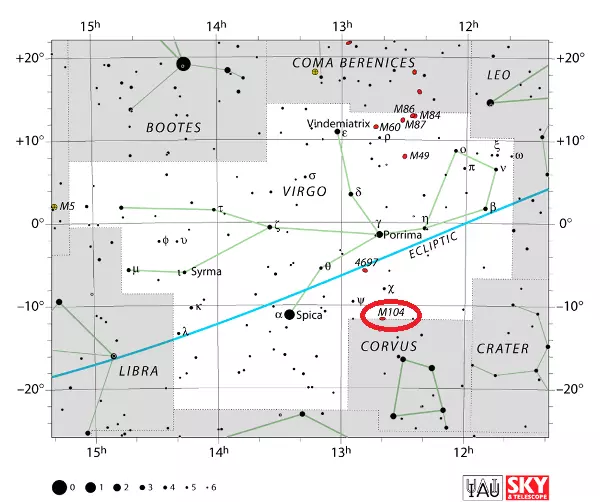
- Messier 68
Constellation: Hydra
Apparent magnitude: 9.67
Apparent size: 11’
The globular cluster M68 can also be found using the stars of Spica’s Spanker. It appears 3.5° south of Kraz (Beta Corvi). The cluster is easily visible in small binoculars, but its brightest stars can only be resolved in 4-inch and larger telescopes.
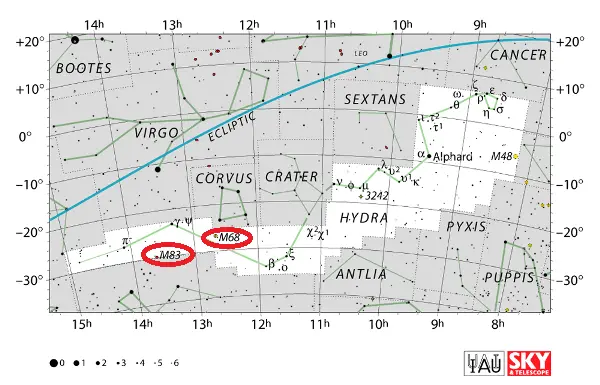
- Messier 83: Southern Pinwheel Galaxy
Constellation: Hydra
Apparent magnitude: 7.54
Apparent size: 12’.9 x 11’.5
The Southern Pinwheel Galaxy (M83) is the southernmost Messier galaxy and can be a challenging target for northern observers because it never appears very high above the horizon. It lies about three quarters of the way and slightly west of the line connecting Spica in Virgo and Menkent in Centaurus, 3.15° south and 6.20° west of the magnitude 3.25 star Pi Hydrae. The galaxy appears as a patch of light in binoculars. The bar structure may be glimpsed in 6-inch telescopes.
- Messier 5
Constellation: Serpens
Apparent magnitude: 5.95
Apparent size: 23’
The globular cluster M5 is found a fist-width north of Zubeneschamali in Libra and two fist-widths southeast of Arcturus in Boötes. The cluster appears as a fuzzy patch of light in binoculars. The individual stars can be resolved in 4-inch and larger telescopes.
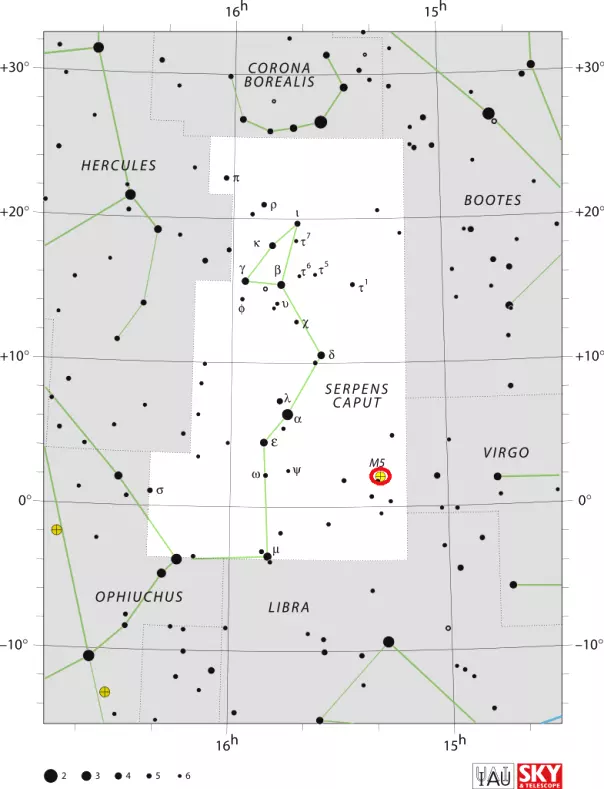
- Messier 13: Hercules Globular Cluster
Constellation: Hercules
Apparent magnitude: 5.8
Apparent size: 20’
The globular cluster M13 appears about 2.5° south of Eta Herculis in the direction of Zeta Herculis. These two stars form an asterism known as the Keystone with Pi and Epsilon Herculis. The Hercules Globular Cluster is visible to the unaided eye on a clear night. It brightest stars can be resolved in 4-inch telescopes.
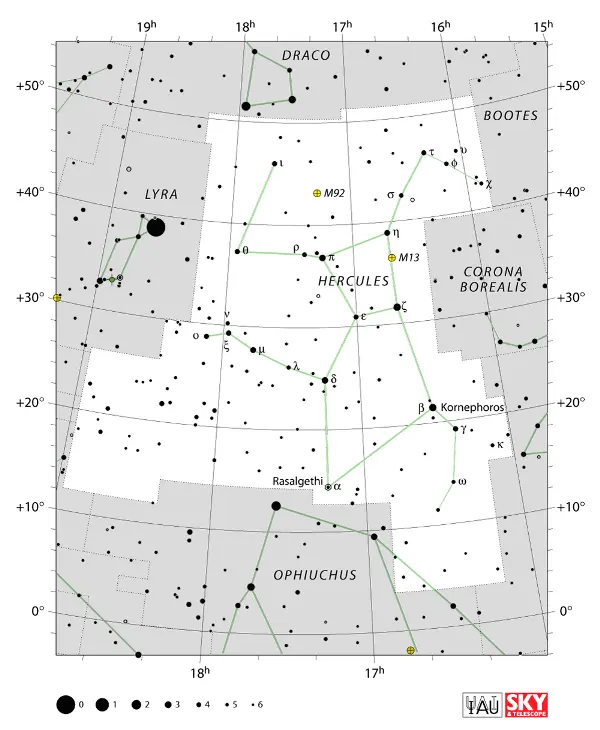
- Messier 92
Constellation: Hercules
Apparent magnitude: 6.3
Apparent size: 14’
The globular cluster M92 appears north of the Keystone, about 60% of the way from Eta Herculis in the Keystone and Iota Herculis. The cluster can also be found by moving 6° from Eltanin in the head of Draco in the direction of the Keystone. The brightest stars in the cluster can be resolved in small and medium telescopes.
- Messier 57: Ring Nebula
Constellation: Lyra
Apparent magnitude: 8.8
Apparent size: 230’’ x 230’’
The Ring Nebula (M57) is easily found using the lyre-shaped pattern of the constellation Lyra. The nebula lies about 40% of the way from Sheliak (Beta Lyrae) to Sulafat (Gamma Lyrae). It can be seen in small telescopes. Medium telescopes will reveal the nebula’s interior hole.
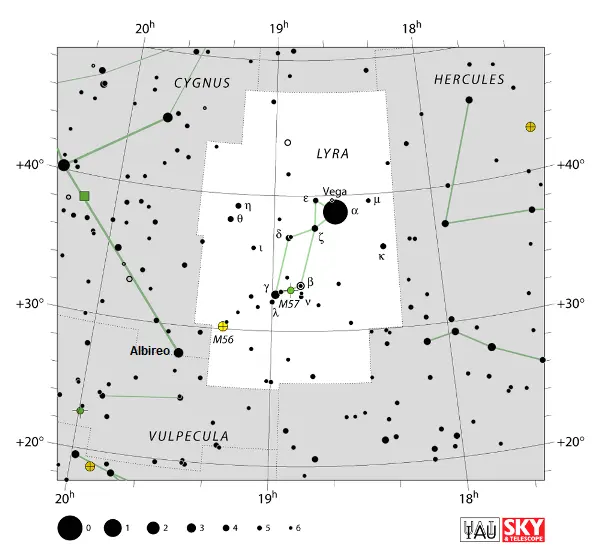
- Messier 56
Constellation: Lyra
Apparent magnitude: 8.3
Apparent size: 8’.8
The globular cluster M56 appears about halfway between Sulafat in the constellation Lyra and Albireo in Cygnus. It appears as a fuzzy patch in larger binoculars and its brightest stars can be resolved in 8-inch or larger telescopes.
- Messier 29
Constellation: Cygnus
Apparent magnitude: 6.6
Apparent size: 7’.0
The open cluster M29 lies 1.7° south and a little east of Sadr (Gamma Cygni), the central star of the Northern Cross in Cygnus. The cluster is visible in binoculars and best observed at low power.
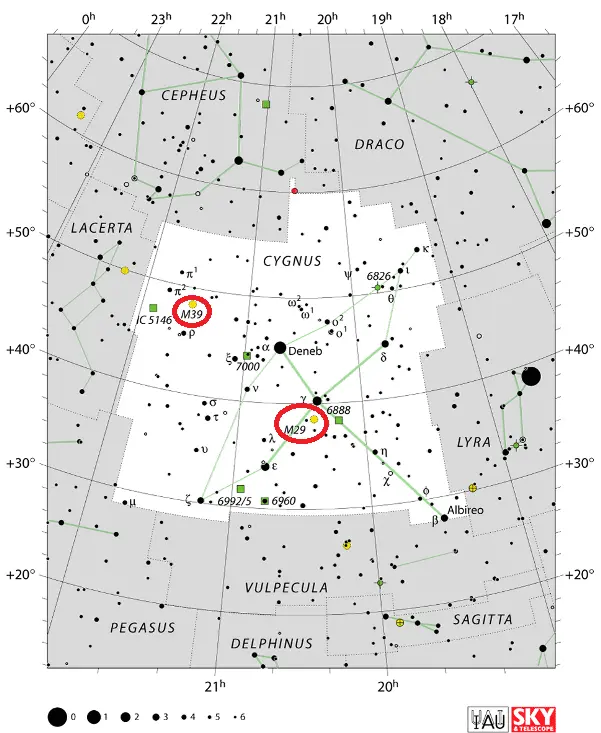
- Messier 39
Constellation: Cygnus
Apparent magnitude: 5.5
Apparent size: 29’
The open cluster M39 appears about 9° east and a little north of Deneb, the brightest star in Cygnus, and 3° north of Rho Cygni. Like M29, it is best observed at the lowest magnifications.
- Messier 27: Dumbbell Nebula
Constellation: Vulpecula
Apparent magnitude: 7.5
Apparent size: 8’.0 x 5’.6
The Dumbbell Nebula (M27) lies about a quarter of the way from Altair in the constellation Aquila to Deneb in Cygnus, just north of the tip of the arrow represented by Sagitta, and roughly halfway between Albireo and the constellation figure of Delphinus. The nebula is visible in larger binoculars. Small telescopes reveal some of the details of its structure.
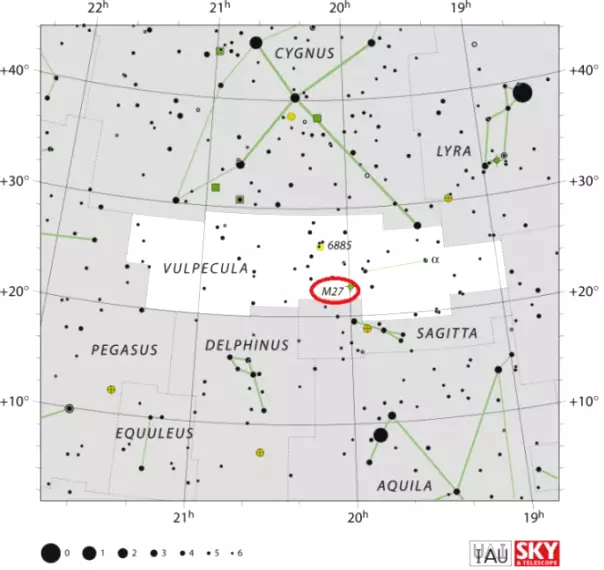
- Messier 71
Constellation: Sagitta
Apparent magnitude: 6.1
Apparent size: 7’.2
The globular cluster M71 is found within the constellation figure of Sagitta. It lies halfway between Gamma and Delta Sagittae. The cluster is visible in binoculars, but only appears as a fuzzy patch of light. Its brightest stars can be resolved in medium telescopes.
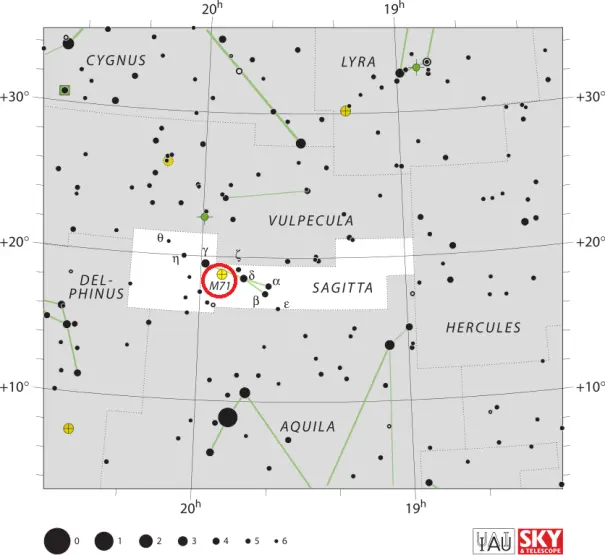
- Messier 12
Constellation: Ophiuchus
Apparent magnitude: 7.68
Apparent size: 16’
The globular cluster M12 lies 5.6° east-southeast of Marfik (Lambda Ophiuchi) or 2° north and 8.5° east of Yed Prior (Delta Ophiuchi). It appears as a hazy ball of light in small telescopes. Its brightest stars can be resolved in 8-inch instruments.
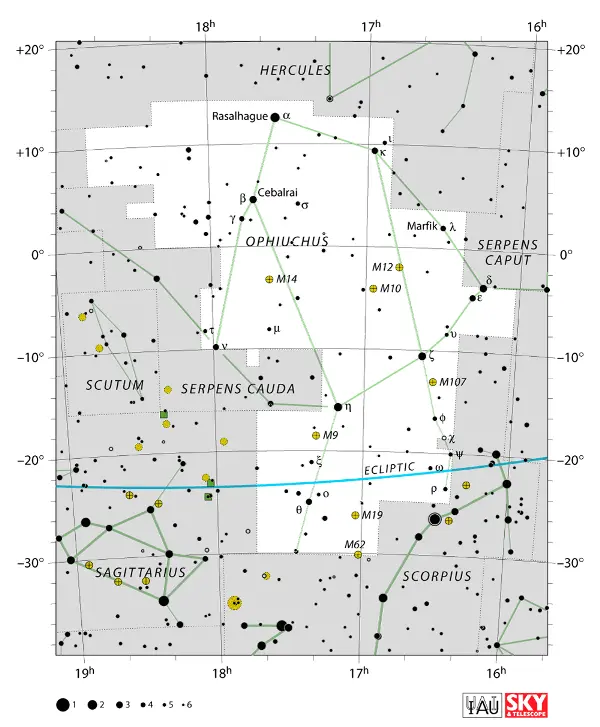
- Messier 10
Constellation: Ophiuchus
Apparent magnitude: 6.4
Apparent size: 20’
The globular cluster M10 lies about a fist width from Cebalrai (Beta Ophiuchi) in the direction of Zeta Ophiuchi. Small telescopes show about half the cluster’s size. M10 lies in the same area as M12. The two clusters are separated by only 3°.
- Messier 14
Constellation: Ophiuchus
Apparent magnitude: 8.32
Apparent size: 11’
The globular cluster M14 lies 0.8° north and 10° east of Messier 10, about a third of the way and a little east of the line extended from Cebalrai (Beta Ophiuchi) to Sabik (Eta Ophiuchi). The cluster is invisible to the unaided eye but can easily be spotted in binoculars.
- Messier 107
Constellation: Ophiuchus
Apparent magnitude: 8.85
Apparent size: 10’
The globular cluster M107 appears 2.75° southwest of Zeta Ophiuchi. It can be seen in binoculars, but only appears as a change in contrast. The cluster is easier to spot in small telescopes. Its brightest stars can be resolved in 6-inch and larger telescopes.
- Messier 9
Constellation: Ophiuchus
Apparent magnitude: 7.9
Apparent size: 9’.3
The globular cluster M9 lies about 3° southeast of Sabik (Eta Ophiuchi), in the direction of Kaus Australis (Epsilon Sagittarii) in Sagittarius constellation. It can be seen in binoculars and small telescopes. The brightest stars in M9 can be resolved in 6-inch telescopes.
- Messier 4
Constellation: Scorpius
Apparent magnitude: 5.9
Apparent size: 26’
The globular cluster M4 is very easy to find. It lies only 1.3° west of Antares, the brightest star in Scorpius and 15th brightest star in the sky. The cluster and the red supergiant appear in the same wide field of view.
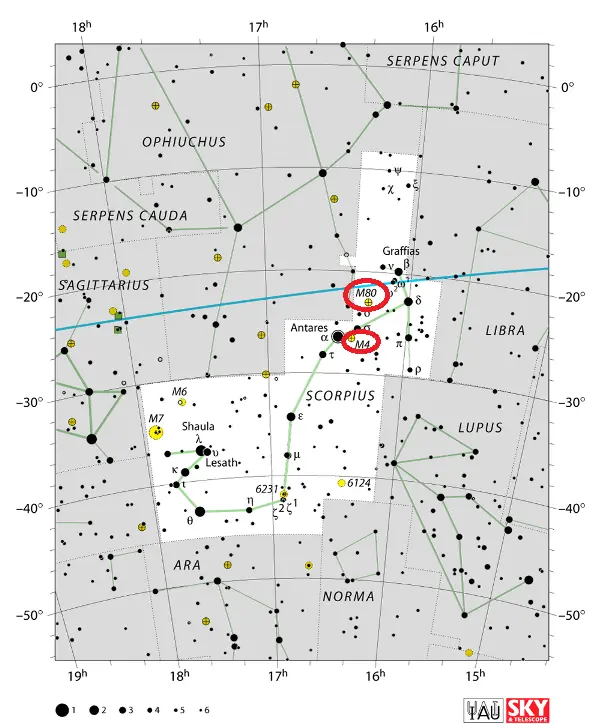
- Messier 80
Constellation: Scorpius
Apparent magnitude: 7.87
Apparent size: 10’.0
The globular cluster M80 appears halfway between Antares (Alpha Scorpii) and Acrab (Beta Scorpii), the northernmost star of the Scorpion’s claws, about 4° northwest of Antares. The cluster is easily observed in small telescopes, but its brightest stars are only resolved by larger instruments.
- Messier 19
Constellation: Ophiuchus
Apparent magnitude: 7.47
Apparent size: 17’
The globular cluster M19 appears 4.5° west-southwest Theta Ophiuchi, a little more than halfway along the imaginary line from Sabik (Eta Ophiuchi) to Larawag (Epsilon Scorpii). It appears as a fuzzy patch in binoculars and can be observed in small telescopes.
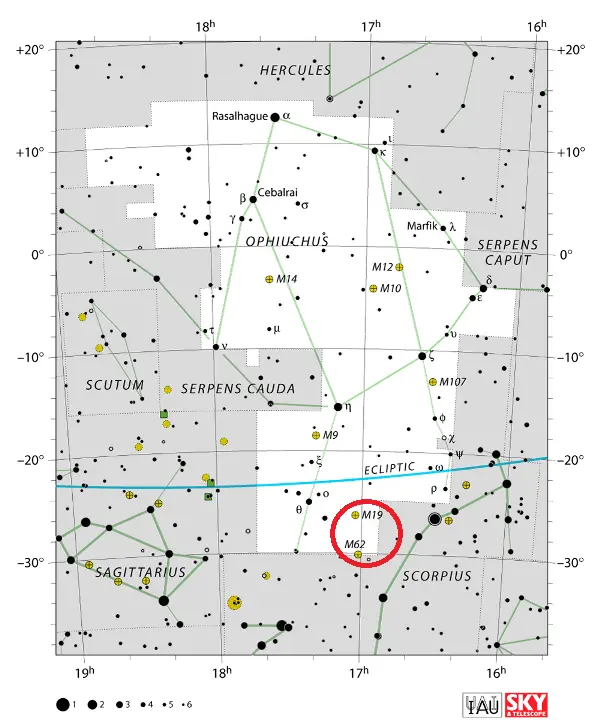
- Messier 62
Constellation: Ophiuchus
Apparent magnitude: 6.45
Apparent size: 15’
The globular cluster M62 lies 7.5° southeast of Antares, in the direction of Kaus Australis in Sagittarius. It can be found 4.75° northeast of Larawag (Epsilon Scorpii). The cluster appears as a dim patch in binoculars and can be observed in small telescopes. Its brightest stars are resolved by 8-inch and larger telescopes. The cluster is never very high above the horizon for observers in the northern hemisphere and can be a challenging target.
- Messier 6: Butterfly Cluster
Constellation: Scorpius
Apparent magnitude: 4.2
Apparent size: 25’
The open cluster M6 lies 5° north and 1.5° east of Shaula (Lambda Scorpii), the star marking the Scorpion’s stinger. The cluster is best seen in binoculars, which reveal a few dozen of its brightest stars.
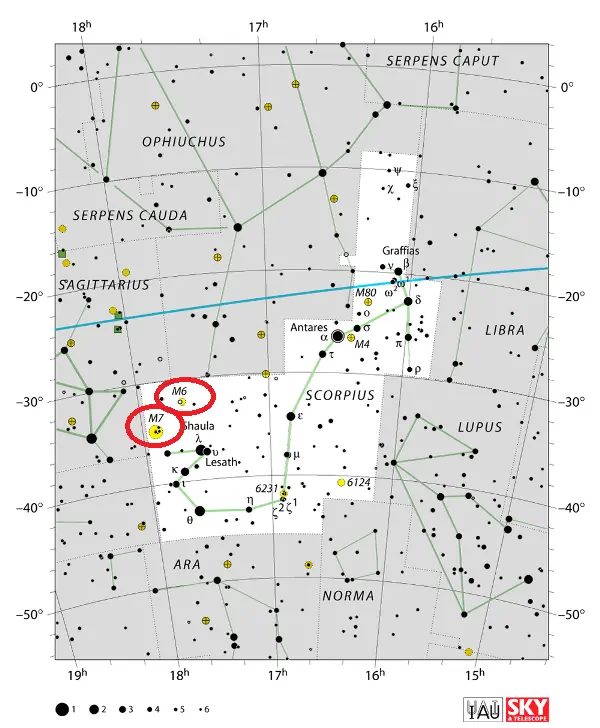
- Messier 7: Ptolemy Cluster
Constellation: Scorpius
Apparent magnitude: 3.3
Apparent size: 80’
The bright open cluster M7 lies in the same region of the sky as the Butterfly Cluster (M6). It is the southernmost object in the Messier catalogue and can be a tricky target for northern observers. The cluster appears 4.75° northeast of Shaula (Lambda Scorpii). It is visible to the unaided eye and easily observed in binoculars.
- Messier 11: Wild Duck Cluster
Constellation: Scutum
Apparent magnitude: 5.8
Apparent size: 22’.8
The Wild Duck Cluster (M11) is the most distant Messier open cluster visible to the unaided eye. It can be found using the bright stars of the celestial Eagle. The cluster lies near the semi-circle of stars in the Eagle’s tail, about 2° west and a little south of Eta Scuti, the star that appears as the extension of the semi-circle that includes the magnitude 3.43 star Lambda Aquilae.
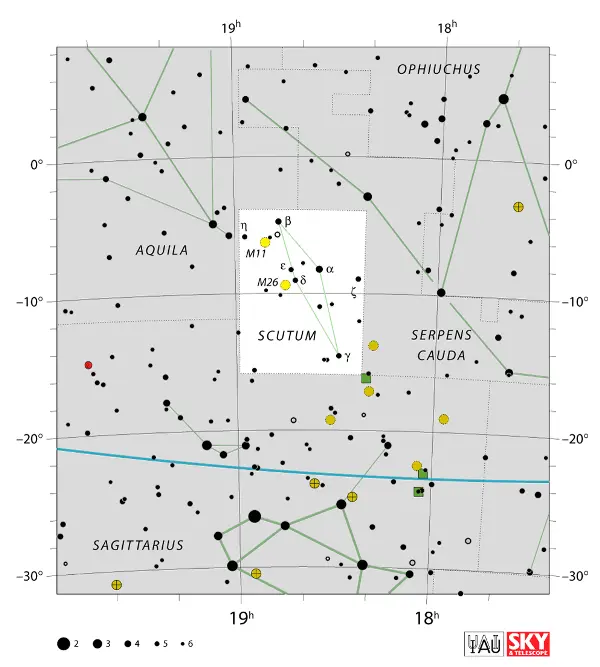
- Messier 26
Constellation: Scutum
Apparent magnitude: 8.0
Apparent size: 14’
The open cluster M26 lies in the same area of the sky as the Wild Duck Cluster (M11) but is significantly fainter. It is visible in binoculars, but its brightest stars can only be resolved in 6-inch and larger telescopes. The cluster can be found by moving from M11 in the direction of Kaus Borealis (Lambda Sagittarii) and extending a line from Alpha through Delta Scuti by about half the distance as that between the two stars.
- Messier 16: Eagle Nebula
Constellation: Serpens
Apparent magnitude: 6.0
Apparent size: 70’ x 50’
The Eagle Nebula (M16) appears at the southern tip of the Serpent’s tail. It can be found by following the line of stars that form the Eagle’s back to where it intersects with the imaginary line extended from Kaus Australis (Epsilon Sagittarii) through Kaus Media (Delta Sagittarii). M16 is best observed at low power. The brightest stars in the nebula’s young open cluster can be resolved in 4-inch telescopes. The famous Pillars of Creation can only be spotted in 12-inch and larger telescopes.
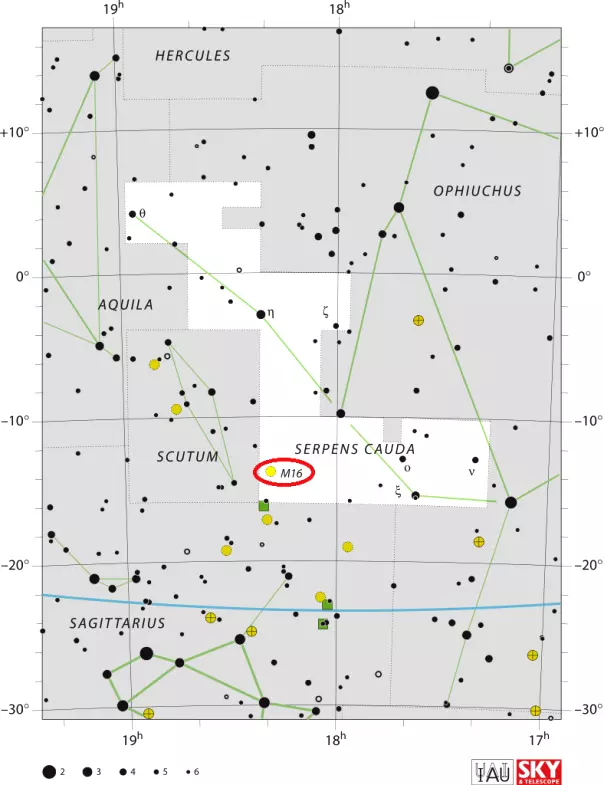
- Messier 17: Omega Nebula
Constellation: Sagittarius
Apparent magnitude: 6.0
Apparent size: 11’
The Omega Nebula (M17) appears just south of the Eagle Nebula (M16), in the same binocular field of view as M16 and the open cluster M18. The nebula can be located by extending a line from Kaus Australis (Epsilon Sagittarii) past just left of Kaus Media (Delta Sagittarii) to the north.
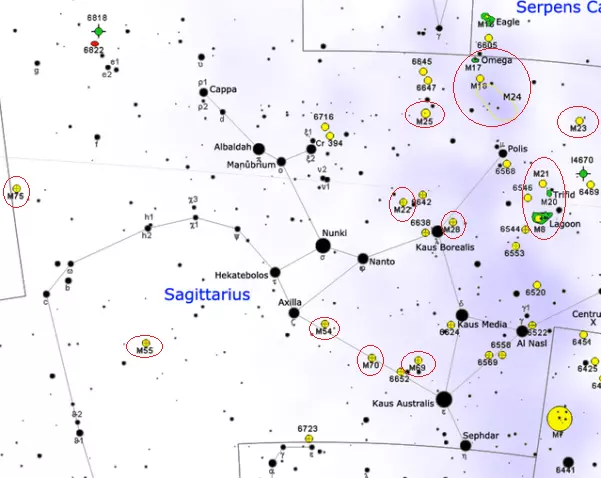
- Messier 18
Constellation: Sagittarius
Apparent magnitude: 7.5
Apparent size: 9’.8
The open cluster M18 lies between the Omega Nebula (M17) and the Small Sagittarius Star Cloud (Messier 24). The easiest way to locate the cluster is to first find M17 and then move a little to the south. The cluster is best observed at low power. Its brightest stars can be resolved in small telescopes.
- Messier 24: Small Sagittarius Star Cloud
Constellation: Sagittarius
Apparent magnitude: 2.5
Apparent size: 2° x 1°
The Small Sagittarius Star Cloud (M24) lies 4° north of Polis (Mu Sagittarii) and 7° north and a little west of Kaus Borealis (Lambda Sagittarii), the star that marks the top of the Teapot asterism. The Milky Way star cloud can also be found by extending the line from Kaus Australis (Epsilon Sagittarii) through Kaus Media (Delta Sagittarii) to the north. It can be observed in small telescopes. The open cluster NGC 6603 in the brightest part of the star cloud is visible in 4-inch telescopes. In good conditions, M24 is visible even without binoculars.
- Messier 25
Constellation: Sagittarius
Apparent magnitude: 4.9
Apparent size: 36’
The open cluster M25 lies 6.5° north and a little east of Kaus Borealis (Lambda Sagittarii), only 3.5° west of the Small Sagittarius Star Cloud. The cluster is best observed in small telescopes.
- Messier 23
Constellation: Sagittarius
Apparent magnitude: 5.5
Apparent size: 35’
The open cluster M23 appears 2.5° north and 3.5° west of Polis (Mu Sagittarii). It is visible in binoculars, but only as a hazy patch. The brightest stars in the cluster can be resolved in small telescopes.
- Messier 21: Webb’s Cross
Constellation: Sagittarius
Apparent magnitude: 6.5
Apparent size: 14’
The open cluster M21 lies 2.5° northwest of the Lagoon Nebula (M8) and 0.75° northeast of the Trifid Nebula (M20). The easiest way to find the cluster is to first locate the two bright nebulae using the stars of the Teapot in Sagittarius and then use the nebulae to find M21. The cluster is visible in binoculars.
- Messier 20: Trifid Nebula
Constellation: Sagittarius
Apparent magnitude: 6.3
Apparent size: 28’
The Trifid Nebula (M20) lies a few degrees west of Kaus Borealis (Lambda Sagittarii), the star at the top of the Teapot, only 2° northwest of the brighter and larger Lagoon Nebula (M8). In exceptionally good conditions, the nebulae are visible to the unaided eye. Both make fine targets in small telescopes.
- Messier 8: Lagoon Nebula
Constellation: Sagittarius
Apparent magnitude: 6.0
Apparent size: 90’ x 40’
The Lagoon Nebula (M8) can be found by extending a line from Nunki (Sigma Sagittarii) through Kaus Borealis (Lambda Sagittarii) by about the same distance as that between the two stars. The nebula lies 5° west of Kaus Borealis.
- Messier 28
Constellation: Sagittarius
Apparent magnitude: 7.66
Apparent size: 11’.2
The globular cluster M28 appears less than 1° northwest of Kaus Borealis (Lambda Sagittarii). The cluster is visible in binoculars, but only as a faint patch of light. It appears in the same area of the sky as the brighter and larger globular cluster M22. The brightest stars in M28 can be resolved in medium telescopes.
- Messier 22: Sagittarius Cluster
Constellation: Sagittarius
Apparent magnitude: 5.1
Apparent size: 32’
The globular cluster M22 is very easy to find. It appears 2.5° northeast of Kaus Borealis (Lambda Sagittarii). The cluster is visible to the unaided eye in good conditions. Its brightest stars can be resolved in small telescopes.
- Messier 69
Constellation: Sagittarius
Apparent magnitude: 8.31
Apparent size: 10’.8
The globular cluster M69 lies within the Teapot, 1.5° from Kaus Australis (Epsilon Sagittarii) in the direction of Phi Sagittarii. It appears as a fuzzy star in binoculars. The brightest stars in the cluster can be resolved in 8-inch telescopes.
- Messier 70
Constellation: Sagittarius
Apparent magnitude: 9.06
Apparent size: 8’.0
The globular cluster M70 appears almost exactly halfway between Kaus Australis (Epsilon Sagittarii) and Ascella (Zeta Sagittarii). Small telescopes reveal it to be a non-stellar object with a bright core. The stars in the outer regions of the cluster can be resolved in 10-inch and larger telescopes.
- Messier 54
Constellation: Sagittarius
Apparent magnitude: 8.37
Apparent size: 12’.0
The globular cluster M54 appears 0.54° south and 1.5° west of Ascella (Zeta Sagittarii), within the Teapot asterism. The cluster is difficult to resolve, even in larger amateur telescopes. It is visible in binoculars and small telescopes.
- Messier 55
Constellation: Sagittarius
Apparent magnitude: 7.42
Apparent size: 19’.0
The globular cluster M55 lies about 17° east of Ascella (Zeta Sagittarii), just south of the imaginary line extended from Kaus Media (Delta Sagittarii) through Ascella. With a low surface brightness, the cluster requires clear, dark skies to be seen. It can be spotted in small binoculars, but its stars can only be resolved in medium and large amateur telescopes.
- Messier 75
Constellation: Sagittarius
Apparent magnitude: 9.18
Apparent size: 6’.8
The globular cluster M75 lies just northeast of the Terebellum asterism in Sagittarius, near the border with Capricornus. The cluster can be observed in small telescopes, but to resolve its stars, one needs at least a 10-inch telescope.
- Messier 15: Great Pegasus Cluster
Constellation: Pegasus
Apparent magnitude: 6.2
Apparent size: 18’
The bright globular cluster M15 lies 3 ½ degrees west and 2 ¼ degrees north of Enif (Epsilon Pegasi), the brightest star in Pegasus, in the direction of Gamma Delphini in Delphinus constellation. Enif is the brightest star roughly halfway between Markab (Alpha Pegasi) in the Great Square of Pegasus and Altair (Alpha Aquilae) in Aquila. M15 is easily observed in binoculars and small telescopes.
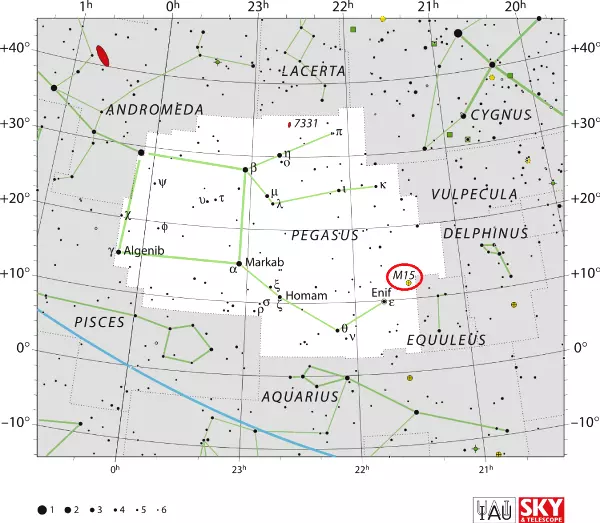
- Messier 2
Constellation: Aquarius
Apparent magnitude: 6.3
Apparent size: 16’
The globular cluster M2 lies 5° north of Sadalsuud (Beta Aquarii) and 10° southwest of Sadalmelik (Alpha Aquarii). It forms a large right-angled triangle with the two stars. The cluster can also be found roughly along the line extended from Zeta Aquarii, the central star of the Water Jar asterism in Aquarius, through Sadalmelik. M2 is visible in binoculars and small telescopes, but its stars can only be resolved in larger instruments.
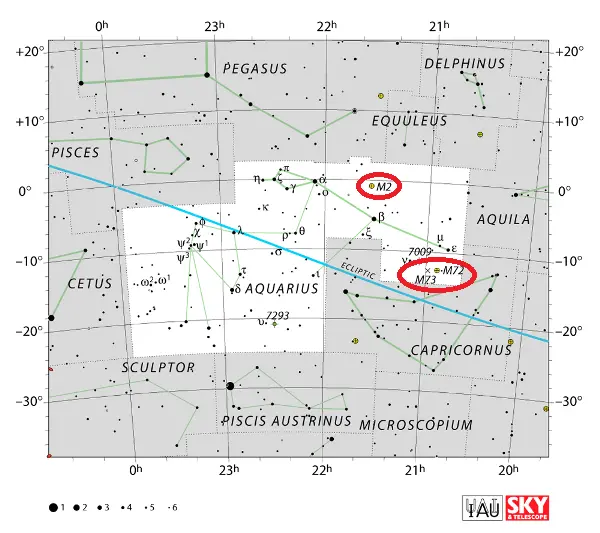
- Messier 72
Constellation: Aquarius
Apparent magnitude: 9.35
Apparent size: 6’.6
The globular cluster M72 lies along the imaginary line extended from Sadalmelik (Alpha Aquarii) through Sadalsuud (Beta Aquarii) in the direction of Dabih (Beta Capricorni). The cluster can also be found using the fainter Albali (Epsilon Aquarii, mag. 3.77); it appears 3° south and 1.5° east of the star. M72 is visible in small telescopes, but only appears as a faint nebula. Its brightest stars can be resolved in medium and larger amateur telescopes.
- Messier 73
Constellation: Aquarius
Apparent magnitude: 9.0
Apparent size: 2’.8
The asterism M73 appears 1.5° east of the globular cluster M72. It lies about halfway and just west of the imaginary line connecting Altair in Aquila and Fomalhaut in Piscis Austrinus. The stars that form the asterism are too faint for small binoculars. The Y shape of the star pattern is visible in 4-inch and larger telescopes.
- Messier 30
Constellation: Capricornus
Apparent magnitude: 7.7
Apparent size: 12’.0
The globular cluster M30 appears almost halfway along the imaginary line drawn from Fomalhaut in Piscis Austrinus to Dabih in Capricornus. The cluster is a challenging target because it lies in an area without any particularly bright stars. It can be found just west of the magnitude 5.24 star 41 Capricorni and a few degrees southeast of the magnitude 3.77 binary star Zeta Capricorni. M30 appears as an elongated patch of light in small binoculars. The brightest stars in the cluster can be resolved in 4-inch and larger telescopes.
